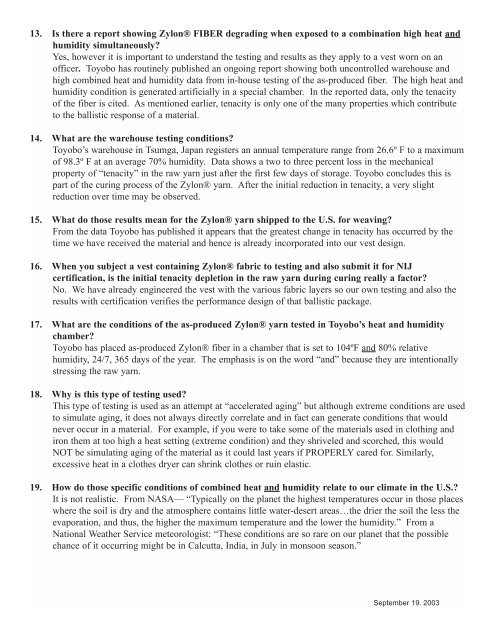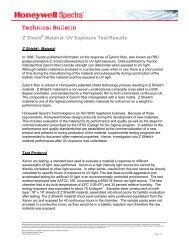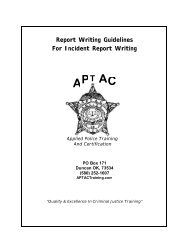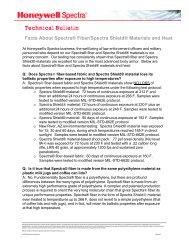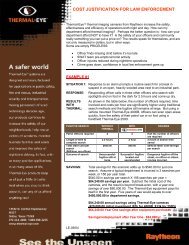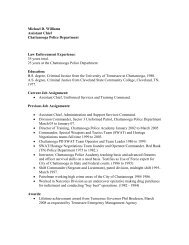FAQs About Zylon® Materials in Body Armor
FAQs About Zylon® Materials in Body Armor
FAQs About Zylon® Materials in Body Armor
You also want an ePaper? Increase the reach of your titles
YUMPU automatically turns print PDFs into web optimized ePapers that Google loves.
13. Is there a report show<strong>in</strong>g Zylon® FIBER degrad<strong>in</strong>g when exposed to a comb<strong>in</strong>ation high heat andhumidity simultaneously?Yes, however it is important to understand the test<strong>in</strong>g and results as they apply to a vest worn on anofficer. Toyobo has rout<strong>in</strong>ely published an ongo<strong>in</strong>g report show<strong>in</strong>g both uncontrolled warehouse andhigh comb<strong>in</strong>ed heat and humidity data from <strong>in</strong>-house test<strong>in</strong>g of the as-produced fiber. The high heat andhumidity condition is generated artificially <strong>in</strong> a special chamber. In the reported data, only the tenacityof the fiber is cited. As mentioned earlier, tenacity is only one of the many properties which contributeto the ballistic response of a material.14. What are the warehouse test<strong>in</strong>g conditions?Toyobo’s warehouse <strong>in</strong> Tsumga, Japan registers an annual temperature range from 26.6º F to a maximumof 98.3º F at an average 70% humidity. Data shows a two to three percent loss <strong>in</strong> the mechanicalproperty of “tenacity” <strong>in</strong> the raw yarn just after the first few days of storage. Toyobo concludes this ispart of the cur<strong>in</strong>g process of the Zylon® yarn. After the <strong>in</strong>itial reduction <strong>in</strong> tenacity, a very slightreduction over time may be observed.15. What do those results mean for the Zylon® yarn shipped to the U.S. for weav<strong>in</strong>g?From the data Toyobo has published it appears that the greatest change <strong>in</strong> tenacity has occurred by thetime we have received the material and hence is already <strong>in</strong>corporated <strong>in</strong>to our vest design.16. When you subject a vest conta<strong>in</strong><strong>in</strong>g Zylon® fabric to test<strong>in</strong>g and also submit it for NIJcertification, is the <strong>in</strong>itial tenacity depletion <strong>in</strong> the raw yarn dur<strong>in</strong>g cur<strong>in</strong>g really a factor?No. We have already eng<strong>in</strong>eered the vest with the various fabric layers so our own test<strong>in</strong>g and also theresults with certification verifies the performance design of that ballistic package.17. What are the conditions of the as-produced Zylon® yarn tested <strong>in</strong> Toyobo’s heat and humiditychamber?Toyobo has placed as-produced Zylon® fiber <strong>in</strong> a chamber that is set to 104ºF and 80% relativehumidity, 24/7, 365 days of the year. The emphasis is on the word “and” because they are <strong>in</strong>tentionallystress<strong>in</strong>g the raw yarn.18. Why is this type of test<strong>in</strong>g used?This type of test<strong>in</strong>g is used as an attempt at “accelerated ag<strong>in</strong>g” but although extreme conditions are usedto simulate ag<strong>in</strong>g, it does not always directly correlate and <strong>in</strong> fact can generate conditions that wouldnever occur <strong>in</strong> a material. For example, if you were to take some of the materials used <strong>in</strong> cloth<strong>in</strong>g andiron them at too high a heat sett<strong>in</strong>g (extreme condition) and they shriveled and scorched, this wouldNOT be simulat<strong>in</strong>g ag<strong>in</strong>g of the material as it could last years if PROPERLY cared for. Similarly,excessive heat <strong>in</strong> a clothes dryer can shr<strong>in</strong>k clothes or ru<strong>in</strong> elastic.19. How do those specific conditions of comb<strong>in</strong>ed heat and humidity relate to our climate <strong>in</strong> the U.S.?It is not realistic. From NASA— “Typically on the planet the highest temperatures occur <strong>in</strong> those placeswhere the soil is dry and the atmosphere conta<strong>in</strong>s little water-desert areas…the drier the soil the less theevaporation, and thus, the higher the maximum temperature and the lower the humidity.” From aNational Weather Service meteorologist: “These conditions are so rare on our planet that the possiblechance of it occurr<strong>in</strong>g might be <strong>in</strong> Calcutta, India, <strong>in</strong> July <strong>in</strong> monsoon season.”September 19. 2003


